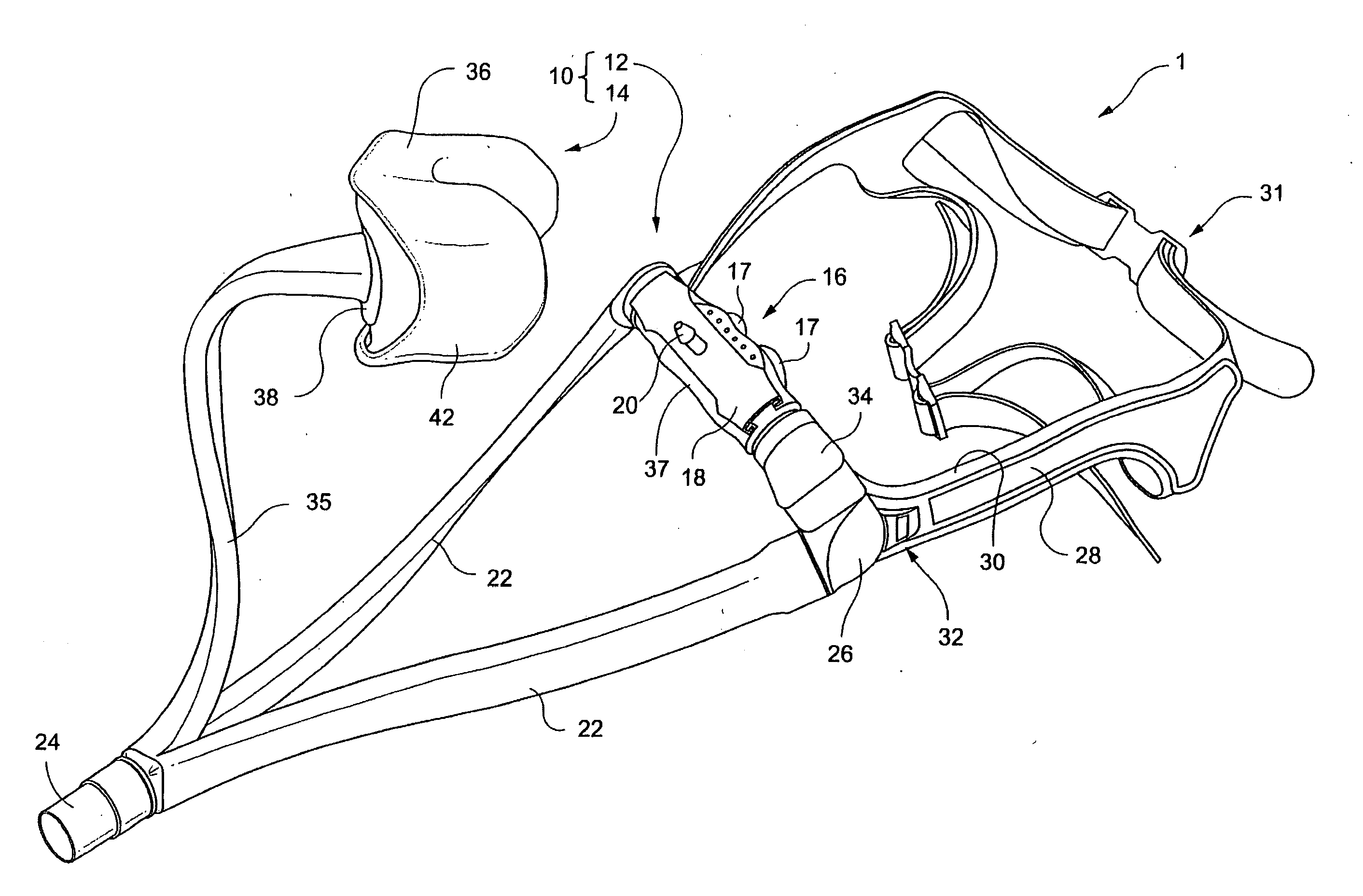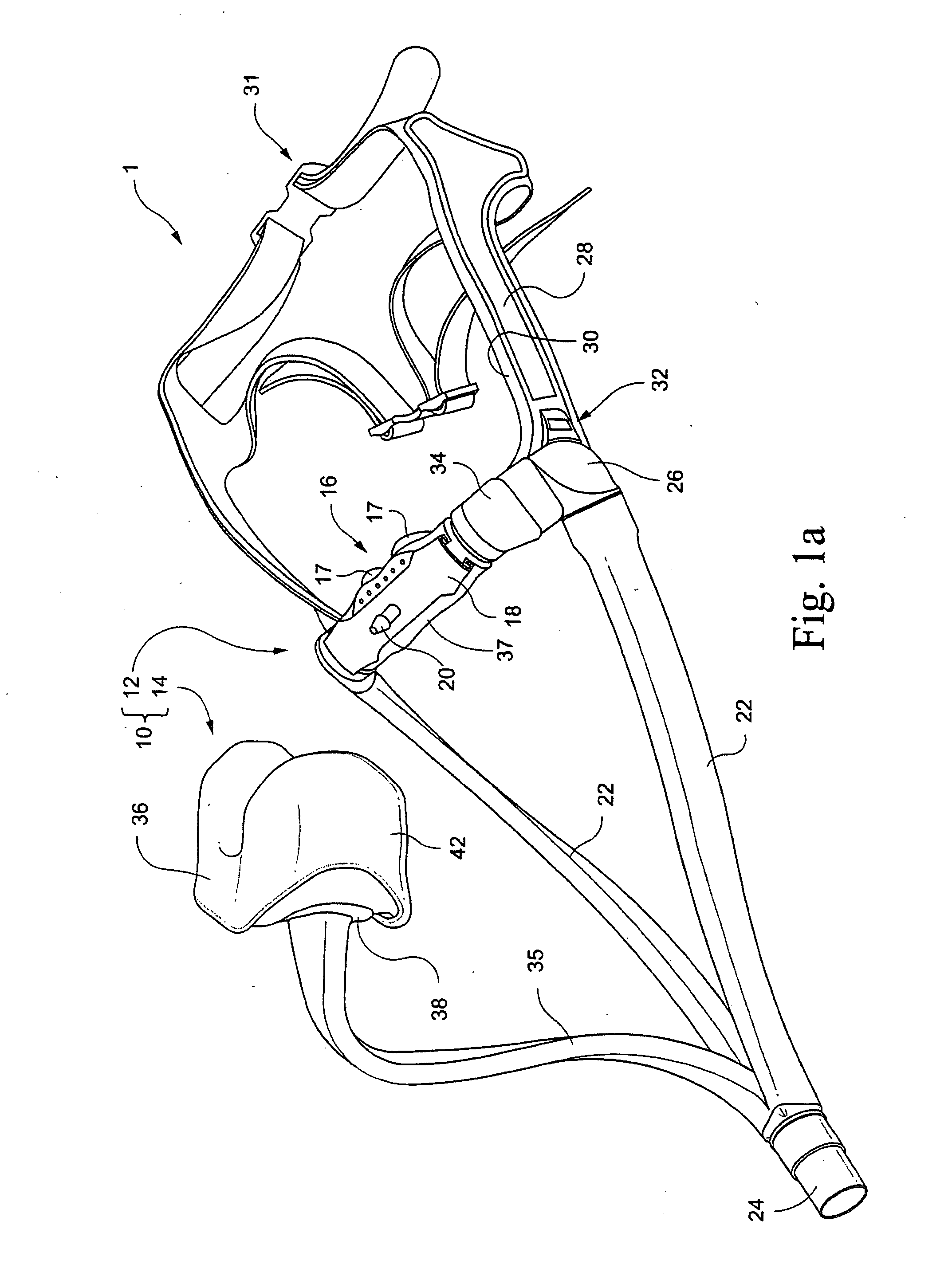Compact oronasal patient interface
a patient interface and oronasal technology, applied in the field of patient interfaces, can solve the problems of increased treatment pressure, ineffective nasal patient interface, mouth leakage, etc., and achieve the effect of preventing or reducing mouth leakage, effective patient interface, and comfortable mouth
- Summary
- Abstract
- Description
- Claims
- Application Information
AI Technical Summary
Benefits of technology
Problems solved by technology
Method used
Image
Examples
first embodiment
[0058]FIGS. 1a-1d illustrate the present invention. As shown in FIG. 1a, a headgear assembly 1 includes a patient interface having a dual chamber assembly 10 including an upper chamber 12 and a lower chamber 14. As shown in FIG. 1a, the lower chamber 14 is in a disconnected position, while FIGS. 1b-1d shown the upper and lower chambers in a connected position.
[0059] Referring to FIG. 1a, the upper chamber 12 includes a nozzle assembly 16 supported by a frame including a first connector on each lateral end thereof, as described in U.S. patent application Ser. No. 10 / 781,929, filed Feb. 20, 2004 and incorporated herein by reference in its entirety. The nozzle assembly 16 is secured to the frame via a clip 18 which in this embodiment supports a pressure measurement port 20. The nozzle assembly 16 may include a pair of nozzles 17 (see FIGS. 1c and 1d).
[0060] One or more inlet conduits 22 is supplied with breathable gas under pressure via a joint 24 coupled to an air delivery tube, whic...
second embodiment
[0066]FIGS. 2a and 2b show the invention. In this embodiment, the lower chamber 14 does not have a direct inlet conduit, like the inlet conduit 35 in FIG. 1a, but instead the air is directed to the upper chamber 12 via the inlet conduits 22 only. Air travels through the flexible element, i.e., through first and second surfaces 36 and 37, from the upper chamber 12 to the lower chamber 14, for example, thus allowing both nose and mouth breathing. FIG. 2b best showed the position where the flexible element would be located between the first and second surfaces 36, 37.
[0067]FIG. 2c shows one example of how the upper and lower chambers 12, 14 may communicate with one another. A mechanical fastener 90 includes first and second parts 92 and 94. The first part 92 may take the form of a thin plate attached to an inside surface 37a of the second part 37 formed on the upper chamber 12. The first part includes an aperture 96. The second part 94 may include a thin plate positioned on the inside ...
third embodiment
[0069] In the invention, as shown in FIGS. 3a and 3b, inlet air is directed directly to the lower chamber 14 through a swivel assembly 50. The upper chamber 12 does not have any inlet conduits but instead the air is directed to the upper chamber 12 by traveling through a conduit extending from the first surface 36 to the second surface 37. The use of a swivel assembly 50 has the advantage that the inlet conduit (not shown, but connected to end 52 of swivel assembly 50) can be routed from any direction. Further, nozzle assembly 16 need not be provided with second connectors 34 and elbow connectors 26 as shown in FIG. 1a. Instead, a pair of plugs 54 may be placed into each end of the nozzle assembly 16, as described in U.S. patent application Ser. No. 10 / 781,929, filed Feb. 20, 2004 and entitled “Nasal Assembly”, incorporated herein by reference in its entirety.
PUM
 Login to View More
Login to View More Abstract
Description
Claims
Application Information
 Login to View More
Login to View More - R&D
- Intellectual Property
- Life Sciences
- Materials
- Tech Scout
- Unparalleled Data Quality
- Higher Quality Content
- 60% Fewer Hallucinations
Browse by: Latest US Patents, China's latest patents, Technical Efficacy Thesaurus, Application Domain, Technology Topic, Popular Technical Reports.
© 2025 PatSnap. All rights reserved.Legal|Privacy policy|Modern Slavery Act Transparency Statement|Sitemap|About US| Contact US: help@patsnap.com



